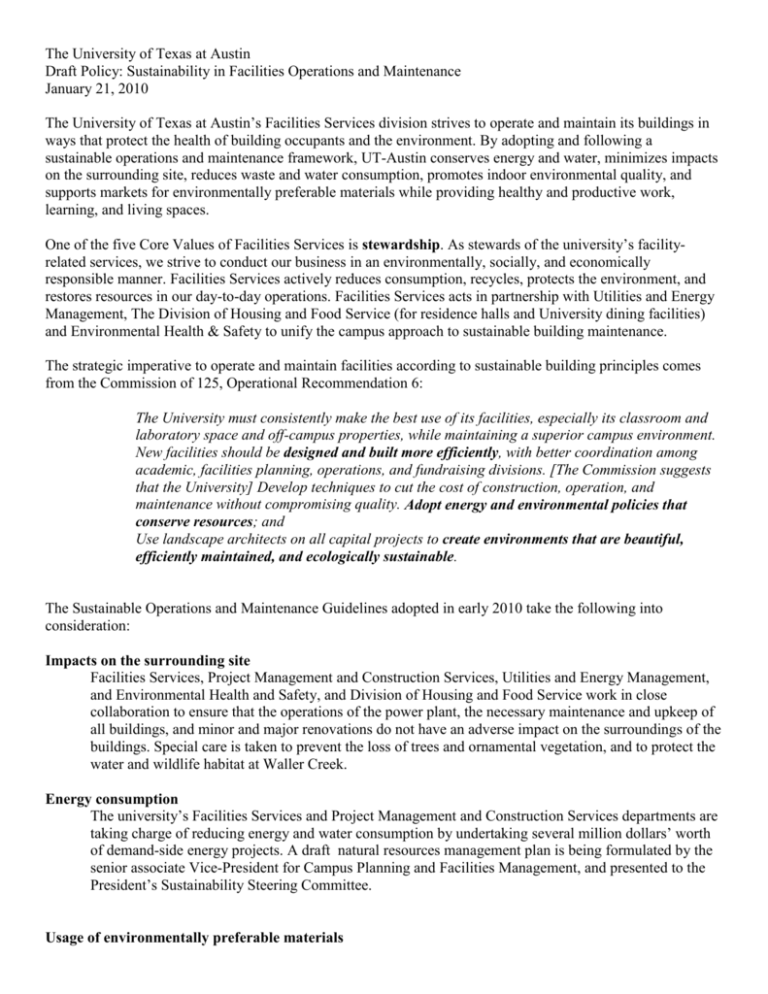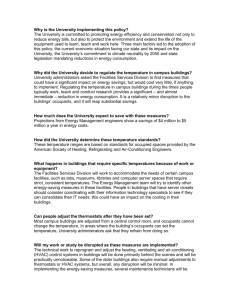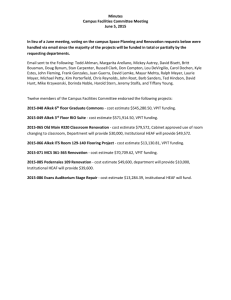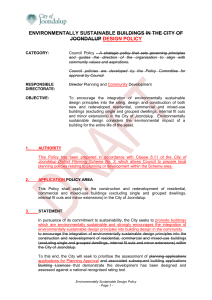Maintenance_Policy_Draft_FINAL
advertisement

The University of Texas at Austin Draft Policy: Sustainability in Facilities Operations and Maintenance January 21, 2010 The University of Texas at Austin’s Facilities Services division strives to operate and maintain its buildings in ways that protect the health of building occupants and the environment. By adopting and following a sustainable operations and maintenance framework, UT-Austin conserves energy and water, minimizes impacts on the surrounding site, reduces waste and water consumption, promotes indoor environmental quality, and supports markets for environmentally preferable materials while providing healthy and productive work, learning, and living spaces. One of the five Core Values of Facilities Services is stewardship. As stewards of the university’s facilityrelated services, we strive to conduct our business in an environmentally, socially, and economically responsible manner. Facilities Services actively reduces consumption, recycles, protects the environment, and restores resources in our day-to-day operations. Facilities Services acts in partnership with Utilities and Energy Management, The Division of Housing and Food Service (for residence halls and University dining facilities) and Environmental Health & Safety to unify the campus approach to sustainable building maintenance. The strategic imperative to operate and maintain facilities according to sustainable building principles comes from the Commission of 125, Operational Recommendation 6: The University must consistently make the best use of its facilities, especially its classroom and laboratory space and off-campus properties, while maintaining a superior campus environment. New facilities should be designed and built more efficiently, with better coordination among academic, facilities planning, operations, and fundraising divisions. [The Commission suggests that the University] Develop techniques to cut the cost of construction, operation, and maintenance without compromising quality. Adopt energy and environmental policies that conserve resources; and Use landscape architects on all capital projects to create environments that are beautiful, efficiently maintained, and ecologically sustainable. The Sustainable Operations and Maintenance Guidelines adopted in early 2010 take the following into consideration: Impacts on the surrounding site Facilities Services, Project Management and Construction Services, Utilities and Energy Management, and Environmental Health and Safety, and Division of Housing and Food Service work in close collaboration to ensure that the operations of the power plant, the necessary maintenance and upkeep of all buildings, and minor and major renovations do not have an adverse impact on the surroundings of the buildings. Special care is taken to prevent the loss of trees and ornamental vegetation, and to protect the water and wildlife habitat at Waller Creek. Energy consumption The university’s Facilities Services and Project Management and Construction Services departments are taking charge of reducing energy and water consumption by undertaking several million dollars’ worth of demand-side energy projects. A draft natural resources management plan is being formulated by the senior associate Vice-President for Campus Planning and Facilities Management, and presented to the President’s Sustainability Steering Committee. Usage of environmentally preferable materials Project Management and Construction Service’s strategic goal includes developing “a renovation program which enhances the sustainability of campus facilities in support of the educational, research, and public goals of the university.” PMCS is currently working towards this strategic goal by: Incorporating life cycle cost management into the selection of materials and equipment. Promoting greater environmental sensitivity in the design and construction of renovation projects for the 15.4 million gross square feet of building space we serve on the university campus. PMCS aims for enduring and resource efficient performance throughout a building’s entire life cycle – from design to construction, operation, maintenance, renovation and deconstruction. Indoor environmental quality Facilities Services Custodial Services uses the OS1 ManageMen organizational and green cleaning system to take care of the custodial needs of the buildings they maintain. (OS1) Green Certified Programs can demonstrate the following: Cleaning for Health first and then for appearance Disposing of cleaning wastes in a environmentally responsible manner Increased worker safety and awareness Increased level of sanitation of building surfaces Responsible and proper removal of pollutants from the facility Reduction of chemical, particle and moisture residue Minimization of human exposure to pollutants The Office of Environmental Health and Safety (EHS) has primary responsibility for indoor air quality issues throughout the institution- main campus and satellite locations. EHS has had a written Indoor Air Quality Plan since 2001 and the program is directed by a Certified Industrial Hygienist (CIH) with support from certified and licensed asbestos, lead paint and mold experts. Instruments are routinely used to measure volatile organic compounds, carbon monoxide, carbon dioxide, relative humidity, temperature, flammable vapors, airborne mold and particulates. Facilities Services Preventive Maintenance monitor pressure drops and change HVAC air filters quarterly, as necessary. Facilities inspects and service motors and fans every 4 months. Coils are cleaned annually. All buildings have at least MERV-8 efficiency filters. Many buildings have direct digital control automation systems and these AC systems can be monitored and controlled. Direct digital controls are standard on all new buildings and included in major renovations. Water consumption The UT Demand-Side Energy Management (Facilities Services) projects initiated in 2007 have already replaced or repaired over 6000 water fixtures throughout campus. Utilities and Energy Management has had an active water recovery program since the 1980s. Water is recovered that has been used for cooling laboratory equipment, swimming pool drain water, groundwater, and air conditioning condensate, and is used to offset evaporation in our cooling towers. No recycled water is used for drinking, flushing or any other "domestic" purpose. In the history of the program, the university has recycled more than 1.3 billion gallons. This is enough water to fill about 50,000 residential swimming pools. By spring 2011, the university will begin using highly treated wastewater for irrigation and for making up evaporative losses in campus cooling towers. This will allow the university to replace consumption of about 400 million gallons of drinking water per year with non-potable water, helping to lessen the burden on city’s infrastructure and delaying the costly construction of a new drinking water treatment plant. While this water is not dangerous to incidental contact, it is non-potable. We continue to reduce water use in the University’s large ornamental fountains,. Almost all the fountains on campus are the recirculating type that use the minimum amount of water. We monitor the water usage of all the outdoor fountains and look for leaks or incorrect adjustments if water use goes up. Auxiliary Operations Division of Housing and Food Service The Division of Housing and Food Service coordinates and/or performs all maintenance and renovations in the campus residence halls, University apartments, and dining centers. To meet the sustainable operations and maintenance goals, Capital projects are coordinated with Project Management and Construction Services and HVAC system performance is coordinated with Facilities Services. In conjunction with the Office of Environmental Health and Safety, hazardous material remediation is coordinated by Housing and Food Service staff licensed for the design, supervision, and inspection of asbestos-containing and lead-based materials. All custodial operations within the department are selfperformed. The most environmentally sensitive and effective cleaning products are specified and used. All maintenance and renovation efforts require the use of environmentally preferable products and require the installation of energy and water conserving equipment and appliances when replacements are made. Food Service management coordinates sustainable efforts in the dining centers, including food waste reduction and composting. A comprehensive recycling program for paper products, plastic, and aluminum is in place for all divisional staff and all residents. Residential programming regularly features topics relating to sustainability, recycling, and environmental stewardship. Information Technology staff continually develop systems that reduce and/or eliminate the requirement for paper products and retention of paper records.







